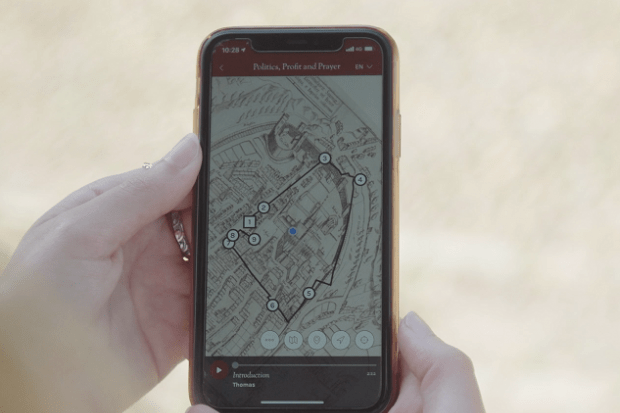Despite the ubiquity of smartphones in most areas of modern life, historians have been slow in thinking about how these devices might reshape how our discipline communicates its research to a range of audiences.
This seems like a missed opportunity. Smartphones are portable, location-sensitive and versatile gadgets whose screens and speakers are ideal for delivering complex content. Their apps provide a form of publication – convenient and interactive – that can communicate some material more effectively than a printed journal paper or book.
Here, I must declare an interest. I lead Hidden Cities, an ongoing experiment in doing history differently that has, to date, produced six apps that include multiple trails around the cities of Exeter, Florence, Hamburg, Valencia, Deventer (the Netherlands) and Trento (Italy). We are also planning apps for Copenhagen, Venice and Tours, and the project is also moving beyond its early modern origins, starting with a Spanish Civil War trail around Valencia.
These free apps, each with a corresponding guide on Apple Maps, adopt a light form of augmented reality (AR). Users can explore the city on georectified historical maps in the company of a “guide” from the past, seeking out visual traces that are often hidden in plain sight.
For our “Dissolution and Dissent” trail for the Hidden Exeter app (made with Reformation expert James Clark), our protagonist is Elizabeth Glandfield, a little-known figure who, in 1536, led a citizens’ resistance movement against Henry VIII’s suppression of the city’s oldest monastery, St Nicholas Priory. Elizabeth and her fully fictional brother, William, a fuller of wool with Protestant sympathies, narrate two sides of the debate around the tumultuous changes to the city (and country’s) religious life as the Reformation picks up momentum.
They weave their way through nine sites, such as the Guildhall where Elizabeth is interrogated by the Sheriff of Devon, a church that houses an altarpiece untouched by the stripping of the altars, and the city walls (or a fragment of them) that withstood siege during the so-called Prayerbook Rebellion. As they do so, they touch on subjects that range from the archaeological evidence of the first turkeys eaten in England to fly-posted leaflets of religious dissent and the remarkable story of the successful (though short-lived) defence of St Nicholas Priory by the local community.
We hope that this form of storytelling, using some degree of fictional interpolation to fill the gaps in the historical record (akin to Saidiya Hartman’s practice of “critical fabulation”) gives audible voice to what may otherwise seem abstract concepts about modes of life and ways of thinking. At the same time, they might also create a dialogue between city dwellers in the past and present.
Of course, this is only one model for how historians can use AR with smartphones. The bigger point is that, whether first-person interpretation is used or not, short-form narrative delivered through audio can convey complex themes in current scholarship while diversifying the places, stories and social groups presented as heritage – which is very often associated with the grand houses or expensive relics left by the elites.
Mobile media also helps operationalise often theorised ideas of “museums without walls”, whereby artefacts in museum collections can be virtually relocated to their original sites through images and audio. For Hidden Cities, museum partners such as Exeter’s Royal Albert Memorial Museum have proved powerful allies in the development and delivery of research, and through the identification of artefacts.
Connecting the urban fabric to displaced objects from museum collections also encourages closer collaboration between academic researchers and curatorial staff. This might lead to fresh interpretation of objects of value to curators and create new connections between museums and their cities, perhaps even helping increase visitor numbers.
Furthermore, locative media tools are valuable for teaching. For Hidden Cities, we have used a version of the app that allows us to guide students through a very similar process: exploring urban history questions by reconstructing the past relationships between material and social worlds, and curating this as locative public history. In their group-based projects focused on Florence, our students have explored topics as varied as a day in the life of Michelangelo, following a trail of street writing and graffiti, and considering the visual media language of souvenirs.
Smartphones have sometimes been seen as the bane of academics, as students furtively text and web browse during lectures – and even exams. However, used wisely, technology can enliven most aspects of academic activity, from research through to teaching and dissemination. With imagination and innovation, humanities scholars can put these devices to work while retaining scholarly integrity and strengthening the learning experience.
Fabrizio Nevola is professor of art history and visual culture at the University of Exeter, principal investigator for Hidden Cities (funded by European Union’s Humanities in European Research Area initiative) and co-editor of an open-access book of the same name.





